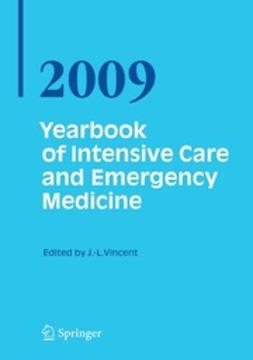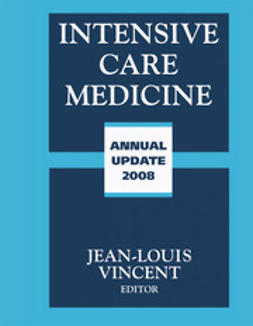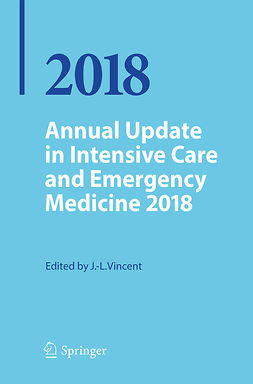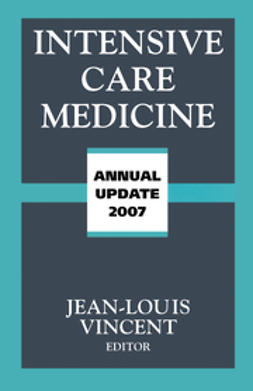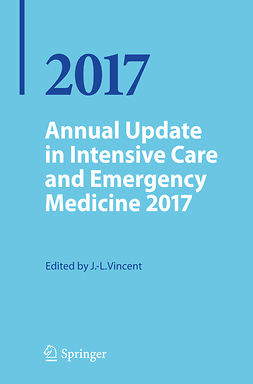Vincent, Jean-Louis
Yearbook of Intensive Care and Emergency Medicine
I. Genomics and Proteomics
1. Rethinking Sepsis: New Insights from Gene Expression Profiling Studies
B. M. Tang, S. J. Huang, A. S. McLean
2. Mitochondrial Genetics and Sepsis
A. Pyle, P. Chinnery, S. Baudouin
3. Lung Proteomics in Intensive Care
E. Kipnis, K. Hansen
II. Inflammatory Response
4. The Host Response to Sepsis
T. J. Hommes, W. J. Wiersinga, T. Poll
5. Endotoxin Tolerance:Mechanisms and Clinical Applicability
A. Draisma, J. G. Hoeven, P. Pickkers
6. Oxidative Stress and Endothelial Dysfunction during Sepsis
O. Huet, A. Harrois, J. Duranteau
7. Measurement of Carbon Monoxide: From Bench to Bedside
F. Corrêa, F. E. Nacul, Y. Sakr
8. Monitoring Immune Dysfunction in Septic Patients: Toward Tailored Immunotherapy
F. Venet, A. Lepape, G. Monneret
III. Current and Future Management of Sepsis
9. Source Control in the ICU
J. J. Waele, M. M. L. G. Malbrain, I. E. Laet
10. IgM-enriched Immunoglobulins in Sepsis
F. Esen, S. Tugrul
11. Clarithromycin: A Promising Immunomodulator in Sepsis
E. J. Giamarellos-Bourboulis
12. High-flow Hemofiltration as an Adjunctive Therapy in Sepsis
P. M. Honoré, O. Joannes-Boyau, W. Boer
13. Economic and Social Burden of Severe Sepsis
E. Silva, D. V. Araujo
IV. Proposed Targets for New Therapies
14. Lymphocyte Apoptosis in Sepsis and Potential Anti-apoptotic Strategies
S. Weber, B. Baessler, S. Schroeder
15. The Pivotal Role of Beta-adrenoreceptors in Critical Illness Pathophysiology
G. L. Ackland, A. J. Patterson
16. Non-septic Acute Lung Injury and Inflammation: Role of TLR4
E. Lorne, H. Dupont, E. Abraham
17. Hydrogen Sulfide: A Metabolic Modulator and a Protective Agent in Animal Models of Reperfusion Injury
C. Szabö, P. Asfar, P. Radermacher
V. Septic Shock
18. ‘Myocardial Depression’ or’ Septic Cardiomyopathy’?
K. Werdan, A. Oelke, U. Müller-Werdan
19. Determinants of Tissue PCO
A. Dubin, V. S. K. Edul, C. Ince
20. Refining the Tools for Early Goal-directed Therapy in Septic Shock
E. Kipnis, E. Robin, B. Vallet
VI. Intravenous Fluids
21. Hyperchloremic Metabolic Acidosis: More than Just a Simple Dilutional Effect
S. S. Abdel-Razeq, L. J. Kaplan
22. Old versus New Starches: What do We Know about their Differences?
C. Hartog, F. M. Brunkhorst, K. Reinhart
23. Impact of Hydroxyethyl Starch on Renal Function
G. Marx, L. Hüter, T. Schuerholz
24. Rational Approach to Fluid Therapy in Acute Diabetic Ketoacidosis
J. Ochola, B. Venkatesh
VII. Hemodynamic Support
25. Cardiac Filling Volumes and Pressures in Assessing Preload Responsiveness during Fluid Challenges
R. -M. B. G. E. Breukers, R. J. Trof, A. B. J. Groeneveld
26. Update on Preload Indexes: More Volume than Pressure
G. Della Rocca, M. G. Costa, L. Spagnesi
27. Monitoring Arterial Blood Pressure and Cardiac Output using Central or Peripheral Arterial Pressure Waveforms
J. Smith, L. Camporota, R. Beale
28. Intrathoracic Pressure Regulation for the Treatment of Hypotension
I. Cinel, A. Metzger, R. P. Dellinger
29. Functional Hemodynamic Monitoring: A Personal Perspective
M. R. Pinsky
VIII. Airway Management
30. Endotracheal Intubation in the ICU
S. Jaber, B. Jung, G. Chanques
31. Pediatric Advanced Airway Management Training for Non-anesthesia Residents
A. Nishisaki, V. M. Nadkarni, R. A. Berg
32. Automatic Tube Compensation in the Weaning Process
J. Cohen, M. Shapiro, P. Singer
IX. Mechanical Ventilation
33. Extracorporeal Membrane Oxygenation for Cardiac and Pulmonary Indications: Improving Patient Safety
R. Kopp, S. Leonhardt, S. Kowalewski
34. Patient-ventilator Interaction during Noninvasive Ventilation
P. Jolliet, D. Tassaux, L. Vignaux
35. Variable Mechanical Ventilation: Breaking the Monotony
M. Gama Abreu, P. M. Spieth, P. Pelosi
36. Life-threatening Asthma: Focus on Lung Protection
H. Quiroz Martinez, N. D. Ferguson
X. Respiratory Monitoring
37. Bedside Monitoring of Diaphragm Electrical Activity during Mechanical Ventilation
C. Sinderby, J. Beck, L. Brander
38. Electrical Impedance Tomography
E. L. V. Costa, R. Gonzalez Lima, M. B. P. Amato
39. Regional Ventilation Delay Index: Detection of Tidal Recruitment using Electrical Impedance Tomography
T. Muders, H. Luepschen, C. Putensen
40. Different Approaches to the Analysis of Volumetric Capnography
F. Suarez Sipmann, S.H. Böhm, G. Tusman
41. Variation in Extravascular Lung Water in ALI/ARDS Patients using Open Lung Strategy
F. J. Belda, G. Aguilar, C. Ferrando
42. Clinical Utility of Extravascular Lung Water Measurements
X. Monnet, J. -L. Teboul
XI. Perioperative Management
43. Rationalizing the Use of Surgical Critical Care: The Role of Cardiopulmonary Exercise Testing
S. J. Davies, R. J. T. Wilson
44. Advanced Minimally Invasive Hemodynamic Monitoring of the High-risk Major Surgery Patient
D. W. Green
45. Post-pneumonectomy Pulmonary Edema
D. Cook, E. Powell, F. Gao-Smith
46. The Role of Phenylephrine in Perioperative Medicine
C. Ertmer, A. Morelli, M. Westphal
47. Role of the Calcium Sensitizer, Levosimendan, in Perioperative Intensive Care Medicine
S. Rehberg, P. Enkhbaatar, D. L. Traber
48. Inhaled Nitric Oxide Therapy in Adult Cardiac Surgery
B. C. Creagh-Brown, T. W. Evans
XII. Cardiac Function
49. Use of Natriuretic Peptides in the Emergency Department and the ICU
T. Reichlin, M. Noveanu, C. Mueller
50. Abnormalities of the ST Segment
D. Gallo, J. M. Pines, W. Brady
51. Functional Mitral Regurgitation in the Critically III
J. Poelaert
XIII. Cardiopulmonary Resuscitation
52. Feedback to Improve the Quality of CPR
J. Yeung, J. Soar, G. D. Perkins
53. The Post-cardiac Arrest Syndrome
J. P. Nolan, R. W. Neumar
54. Use of a Standardized Treatment Protocol for Post-cardiac Resuscitation Care
M. A. Kuiper, P. E. Spronk, M. J. Schultz
55. Therapeutic Hypothermia after Cardiac Arrest
G. Ristagno, W. Tang
XIV. Renal Function
56. Biomarkers of Acute Kidney Injury in Critical Illness
F. Adams, B. Venkatesh
57. The Role of Biomarkers in Cardiac Surgery-associated Acute Kidney Injury
A. Shaw, M. Stafford-Smith, M. Swaminathan
58. Neutrophil Gelatinase- associated Lipocalin: An Emerging Biomarker for Angina Renalis
P. Devarajan
XV. Hepatosplanchnic Function
59. How does Intra-abdominal Pressure Affect the Daily Management of My Patients?
I. E. Laet, J. J. Waele, M. M. L. G Malbrain
60. ICG Clearance Monitoring in ICH Patients
E. Levesque, F. Saliba
61. Acute-on-Chrenic Liver Failure in Cirrhosis: Defining and Managing Organ Dysfunction
D. Shawcross, J. Wendon
XVI. Nutrition
62. The Curse of Overfeedinc and the Blight of Underfeeding
N. -H. W. Loh, R. D. Griffiths
63. Enterai Feeding during Circulatory Failure: Myths and Reality
M. M. Berger, R. L. Chiolero
64. Enterai Nutrition with Anti-inflammatory Lipids in ALI/ARDS
A. Pontes-Arruda, S. J. Michele
65. Glutamine Supplementation in ICU Patients
A. Berg, O. Rooyackers, J. Wernerman
XVII. Glucose Control
66. Burn Causes Prolonged Insulin Resistance and Hyperglycemia
G. G. Gauglitz, M. G. Jeschke
67. Glucose Variability in Critically III Patients
N. A. Ali, J. S. Krinsley, J. -C. Preiser
XVIII. Adrenal Function
68. Corticosteroid Biology in Critical Illness: Modulatory Mechanisms and Clinical Implications
M. Williams, D. K. Menon
69. Corticosteroid Treatment of Patients in Septic Shock
C. L. Sprung, S. Goodman, Y. G. Weiss
XIX. Coagulation
70. New Anticoagulants: Anti-lla or Anti-Xa agents?
C. M. Samama
71. Emergency Reversal of Anticoagulants
M. Levi
XX. Neurological Aspects
72. The Role of Imaging in Acute Brain Injury
R. D. Stevens, A. Pustavoitau, P. Zijl
73. Monitoring and Managing Raised Intracranial Pressure after Traumatic Brain Injury
M. Smith
74. Sepsis-associated Encephalopathy
S. Siami, A. Polito, T. Sharshar
XXI. Malignancies
75. Acute Tumor Lysis Syndrome: Diagnosis and Management
M. Darmon, M. Roumier, E. Azoulay
76. Life-threatening Neurological Complications in Patients with Malignancies
S. Legriel, E. Azoulay
77. Should We Admit Critically III Cancer Patients to the ICU?
D. D. Benoit, P. O. Depuydt, J. M. Decruyenaere
XXII. Drug Dosing
78. Optimizing Drug Dosing in the ICU
X. Liu, P. Kruger, M. S. Roberts
79. Relevant CYP450-mediated Drug Interactions in the ICU
I. Spriet, W. Meersseman
XXIII. Sedation and Analgesia
80. Sedation and Pain Management in the ICU
M. A. Mirski, J. J. Lewin
81. The Role of Dexmedetomidine in Intensite Care
R. Rahman West, A. Rhodes, R. M. Grounds
82. Monitoring Delirium in the ICU
M. Seeling, A. Heymann, C. Spies
XXIV. ICU Management
83. Intensite Care for the Elderly: Current and Future Concerns
H. Wunsch, A. T. Jones, D. C. Scales
84. ICU Performance: Managing with Balanced Scorecards
K. Shukri, F. S. M. Ali
XXV. End-of-Life Issues
85. Towards a Neuro-scientific Explanation of Near-death Experiences?
A. Vanhaudenhuyse, M. Thonnard, S. Laureys
86. Managing Conflict at the End-of-Life
K. Hillman, J. Chen
87. Strengths and Weaknesses of Substitute Decision Making in the ICU
A. Lautrette, H. Azoulay, B. Souweine
Nyckelord: Medicine & Public Health, Intensive / Critical Care Medicine, Emergency Services, Internal Medicine
- Författare
- Vincent, Jean-Louis
- Utgivare
- Springer
- Utgivningsår
- 2009
- Språk
- en
- Utgåva
- 1
- Serie
- Yearbook of Intensive Care and Emergency Medicine
- Sidantal
- 1026 sidor
- Kategori
- Hälsa, skönhet, mode
- Format
- E-bok
- eISBN (PDF)
- 9783540922766

